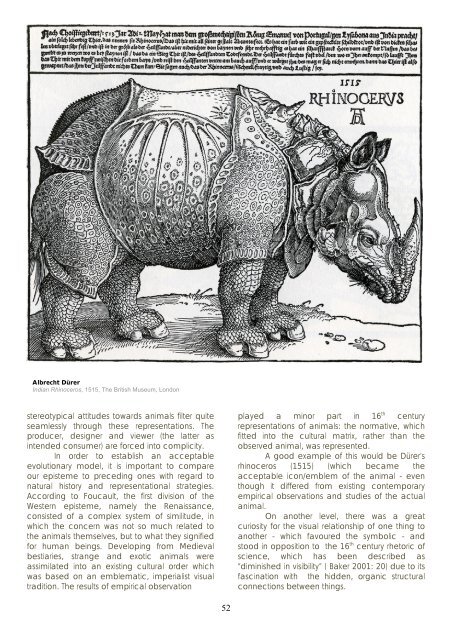Marketing Animals - Antennae The Journal of Nature in Visual Culture
Marketing Animals - Antennae The Journal of Nature in Visual Culture
Marketing Animals - Antennae The Journal of Nature in Visual Culture
Create successful ePaper yourself
Turn your PDF publications into a flip-book with our unique Google optimized e-Paper software.
Albrecht Dürer<br />
Indian Rh<strong>in</strong>oceros, 1515, <strong>The</strong> British Museum, London<br />
stereotypical attitudes towards animals filter quite<br />
seamlessly through these representations. <strong>The</strong><br />
producer, designer and viewer (the latter as<br />
<strong>in</strong>tended consumer) are forced <strong>in</strong>to complicity.<br />
In order to establish an acceptable<br />
evolutionary model, it is important to compare<br />
our episteme to preced<strong>in</strong>g ones with regard to<br />
natural history and representational strategies.<br />
Accord<strong>in</strong>g to Foucault, the first division <strong>of</strong> the<br />
Western episteme, namely the Renaissance,<br />
consisted <strong>of</strong> a complex system <strong>of</strong> similitude, <strong>in</strong><br />
which the concern was not so much related to<br />
the animals themselves, but to what they signified<br />
for human be<strong>in</strong>gs. Develop<strong>in</strong>g from Medieval<br />
bestiaries, strange and exotic animals were<br />
assimilated <strong>in</strong>to an exist<strong>in</strong>g cultural order which<br />
was based on an emblematic, imperialist visual<br />
tradition. <strong>The</strong> results <strong>of</strong> empirical observation<br />
52<br />
played a m<strong>in</strong>or part <strong>in</strong> 16 th century<br />
representations <strong>of</strong> animals: the normative, which<br />
fitted <strong>in</strong>to the cultural matrix, rather than the<br />
observed animal, was represented.<br />
A good example <strong>of</strong> this would be Dürer’s<br />
rh<strong>in</strong>oceros (1515) (which became the<br />
acceptable icon/emblem <strong>of</strong> the animal - even<br />
though it differed from exist<strong>in</strong>g contemporary<br />
empirical observations and studies <strong>of</strong> the actual<br />
animal.<br />
On another level, there was a great<br />
curiosity for the visual relationship <strong>of</strong> one th<strong>in</strong>g to<br />
another - which favoured the symbolic - and<br />
stood <strong>in</strong> opposition to the 16 th century rhetoric <strong>of</strong><br />
science, which has been described as<br />
“dim<strong>in</strong>ished <strong>in</strong> visibility” ( Baker 2001: 20) due to its<br />
fasc<strong>in</strong>ation with the hidden, organic structural<br />
connections between th<strong>in</strong>gs.












